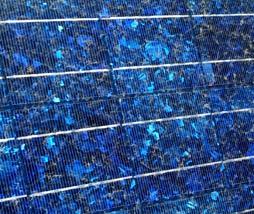Jan 24 2008
Two grants to ASU for development of new solar energy technologies show how ASU’s solar energy research has grown in new and important ways.

The grants, from the U.S. Department of Energy’s (DOE) Solar America Initiative, are for basic research into new solar cell materials that could lead to efficiency gains and lower costs for the technology.
Each grant focuses on developing new materials like those that have been used in advanced semiconductors and applying them to solar energy. They bring to five the number of major solar energy grants ASU has garnered from the DOE in less than a year.
“These two latest grants deal with fundamental research questions and should lead to longer-term solar energy solutions,” says Jonathan Fink, the director of ASU’s Global Institute for Sustainability. “We are one of only four universities to receive more than one of these prestigious awards, along with MIT, Stanford and Penn State.”
Six universities received the majority of DOE awards for solar technology research during the past year: MIT has six, ASU and the University of Delaware have five, and Stanford, Cal Tech and the University of Colorado have three each.
“This shows that ASU is emerging as a very strong competitor in solar energy technology,” says Stephen Goodnick, ASU’s associate vice president for research. “We are the only school in the Southwest to receive a Solar America Initiative grant in either of the first two rounds of awards.”
The Solar America Initiative (SAI) is a DOE effort to accelerate the development of advanced solar energy technologies. The strategy is to pursue complementary activities in the research and development of solar technologies to reduce costs and eliminate barriers to commercialization.
In the first round of SAI awards, ASU won two grants to work with industry partners and help lower the costs of producing and distributing solar energy, bringing its costs more in line with conventional energy sources. DOE also awarded ASU a Basic Energy Sciences grant (to Ian Gould, a professor in chemistry and biochemistry) for a solar energy project last year.
The two new grants in the latest SAI round are geared toward advancing new materials that can be used in photovoltaic solar cells, with a goal of having prototypes developed by 2015 and commercialized by 2020 to 2030.
One SAI grant, for $1.3 million, will go to a team led by John Kouvetakis, a professor in chemistry and biochemistry, and Jose Menendez, a professor in physics. The project will explore the photovoltaic potential of new materials that originally were developed for laser applications. The project promises dramatic cost reductions compared to current technologies.
“The materials we are using have been developed at ASU over the past five years for silicon-based photonic devices,” Kouvetakis says. “The application of these materials in photovoltaics is an extension of our previous work.”
Kouvetakis adds that the goal of the project is to advance silicon-based solar cells, which account for 90 percent of all commercial solar devices, and to use materials the researchers are familiar with from their semiconductor work. The new material combinations will feature enhanced absorption of sunlight by perfectly matching the solar energy spectrum. The ASU researchers are teaming up with ASM America Inc. and EpiWorks Inc. in the project.
The second SAI grant is for $1.14 million and goes to a team headed by Mark van Schilfgaarde, a professor in the School of Materials. That project will focus on developing “tandem cell” solar cells, where two-material combinations are brought together to most efficiently use solar energy. Once again, the materials that are being explored originally were studied at ASU for their semiconductor applications.
The researchers will grow thin films of these materials, which then will be fabricated into photovoltaic devices, van Schilfgaarde says, adding that there are advantages to this route.
“The tandem-cell approach puts one type of material on the top of the cell and a different material on the bottom,” he says. “That way the top and bottom absorb different wavelengths of light, so you get a bigger bang for the buck.”
The ASU team will explore materials other than silicon. Van Schilfgaarde says silicon-processing methods typically are very expensive, as are thin-film approaches that rely on rare elements. His new method will use abundant materials, such as zinc, selenium, phosphorous and germanium. Because they use only thin films of the materials – measuring only microns thick – they can keep production costs relatively low.
“Use of abundant materials is a key,” van Schilfgaarde says. “Use of high-quality semiconductor materials also is essential, because photovoltaics need to be defect-free to be reasonably efficient. We figure if we can get to 20 percent efficiency in three years, then it will be a game-changer.”
The best commercial technologies currently get about 15 percent efficiency.
“These grants show that ASU is building a broad and diverse portfolio in solar energy-related research activities, taking advantage of our strengths in materials characterization and fabrication, flexible-display technology, power systems engineering, photovoltaic testing and evaluation, energy-efficient architecture, urban design, decision science and resource economics,” Fink says of the recent SAI grants. “Most important is that we are able to bring all of the people together and have them strategize as a group."